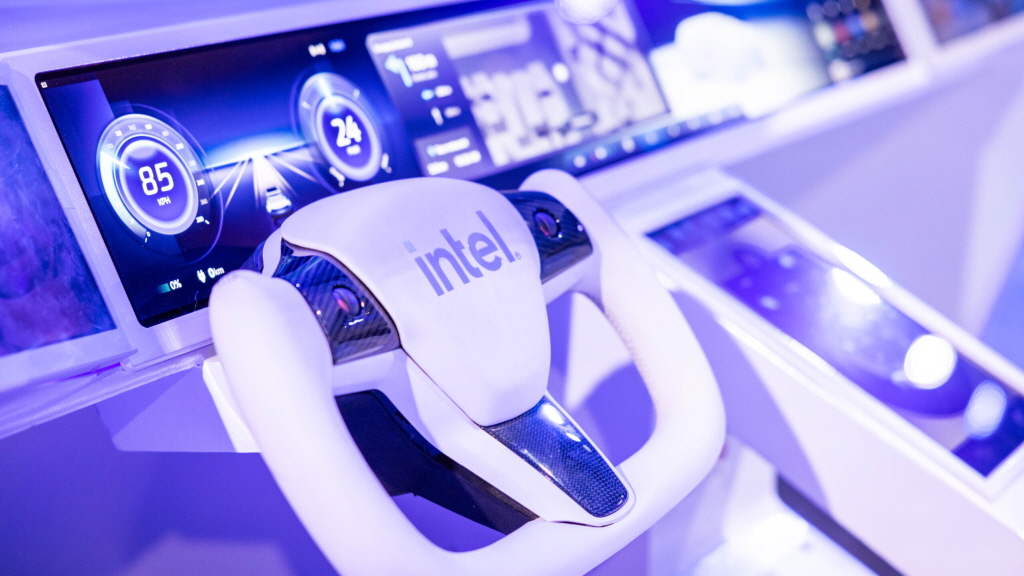인텔(Intel)이 CES 2025서 새로운 적응형 제어 솔루션, 차세대 외장 그래픽, AWS VDE(가상 설계 환경) 등을 공개하며, 소프트웨어 정의 차량(SDV) 시대를 본격 공략한다.
CES 2025 새로운 적응형 제어 솔루션·차세대 외장 그래픽 등 공개
인텔이 CES 2025서 새로운 적응형 제어 솔루션, 차세대 외장 그래픽, AWS VDE(가상 설계 환경) 등을 공개하며, 소프트웨어 정의 차량(SDV) 시대를 본격 공략한다.
인텔은 CES 2025에서 자동차 제조업체의 전기차 및 SDV(소프트웨어 정의 차량, Software-defined vehicles)로의 전환을 가속화하기 위해 확장된 제품 포트폴리오와 새로운 파트너십을 공개했다.
인텔은 고성능 컴퓨팅, 외장 그래픽, 인공지능(AI), 전력 관리 및 영역 컨트롤러 솔루션을 포함한 총체적 차량 플랫폼을 제공하며, AWS(아마존웹서비스)와 공동 개발한 인텔® 오토모티브 VDE(Intel® Automotive Virtual Design Environment)도 함께 선보였다.
인텔은 이러한 접근 방식을 통해 자동차 제조업체의 비용 및 성능 확장성 문제를 해결하고, 더 빠르고 효율적이며 수익성 높은 SDV 개발 및 배포가 가능하도록 지원한다.
인텔의 총체적 차량 플랫폼은 기존의 분산된 차량 아키텍처 접근 방식에서 발생하는 비효율성을 줄여준다. 차량의 전기/전자 아키텍처를 최적화함으로써 인텔은 비용 절감과 성능 향상을 동시에 이끌어낸다. 인텔은 이 플랫폼을 지원하기 위해 전기차(EV) 파워트레인과 영역 컨트롤러 애플리케이션을 위해 설계된 적응형 제어 유닛(ACU)의 출시를 발표했다.
ACU U1310은 여러 실시간, 안전에 중요한 사이버보안 기능, 애플리케이션 및 도메인(X-in-1)을 단일 칩으로 통합하는 새로운 종류의 처리 장치다. 기존의 시간 및 순차 처리 기반 마이크로 및 영역 컨트롤러는 제한된 결정적 처리 역량으로 인해 여러 워크로드를 처리하는 데 한계가 있었다. 반면, 인텔의 새로운 ACU 디바이스 제품군은 CPU 코어에서 실시간 제어 알고리즘을 오프로드하는 유연한 로직 영역을 통합하여 여러 마이크로컨트롤러 워크로드를 단일 영역의 MCU로 통합하는 경우에도 안정적인 성능, FFI(freedom from interference) 및 결정적 데이터 전달을 보장한다. 이러한 듀얼 브레인 접근 방식은 더 많은 워크로드를 통합하고 비용을 절감하며, 안전성, 사이버보안, 성능을 향상시킨다.
전기차 파워트레인에 ACU U310을 적용하면 첨단 알고리즘 솔루션을 통해 배터리의 에너지 수요를 줄이고, 개별 운전 스타일과 도로 조건에 맞춰 고전압 및 제어 주파수를 자동으로 조정할 수 있다. ACU는 킬로와트당 비용 절감 및 에너지 효율 향상을 통해 파워트레인 시스템 에너지 손실의 최대 40%를 회수할 수 있다. 이를 통해 국제표준 배출가스 측정방식(WLTP)에서 3%에서 5%까지의 효율 증가를 실현한다. 이는 차량의 주행 가능 거리 증가, 충전 시간 단축, 더욱 민첩한 주행 경험을 제공하며, 기존 접근 방식에 비해 차량당 자재 비용(BOM), 전기 모터 크기, 배터리 비용을 크게 절감한다.
스텔란티스 모터스포츠(Stellantis Motorsports)는 레이싱 경쟁에서 성능과 효율성을 향상시키기 위해 인텔을 핵심 기술 파트너로 선정하고, 차세대 인버터 제어에 적응형 제어 기술을 도입하고 있다. 인텔 기술은 이를 통해 전기 모터를 제어하고 제동 단계에서 에너지를 회수한다. 특히 인버터는 포뮬러 E 레이스에서 중요한 역할을 하며, 효율성 향상은 곧 경쟁 우위로 직결된다.
카르마 오토모티브(Karma Automotive)는 옵티멀 펄스 패턴(Optimal Pulse Pattern) 제어 알고리즘을 통해 효율성을 개선하고, 토크 리플 감소(Torque Ripple Reduction) 및 레인지 부스트(Range Boost)와 같은 혁신적인 기능을 포함한 4가지 특유의 주행 프로필을 지원하는 인텔 공동 브랜드 인버터를 선보이며, 인텔의 ACU를 지원한다고 발표했다.
ACU의 프로그래밍 가능성 덕분에 다양한 차량 토폴로지와 애플리케이션에 맞게 조정할 수 있는 최초의 소프트웨어 정의 영역 컨트롤러로 사용할 수 있다. 이러한 유연성은 SDV으로의 전환을 간소화하고 공급망을 간소화하며 차량 BOM의 복잡성을 줄여준다.
인텔은 인텔의 1세대 AI 강화 SDV 시스템 온 칩(SoC)을 기반으로 2025년 말 생산 예정인 2세대 오토모티브용 인텔® 아크™ B 시리즈 그래픽(Intel® Arc™ B-series Graphics for Automotive)을 발표했다. 이 솔루션은 보다 발전된 차량 내 AI 워크로드, 차세대 휴먼 머신 인터페이스(HMI) 엔진, 몰입형 차량 내 경험 및 AAA PC 게이밍에 필요한 고성능 컴퓨팅을 제공한다. 인텔 AI로 강화된 SDV SoC와 결합하여 방대한 인텔 AI 에코시스템의 지원을 받아 복잡한 AI 워크로드를 위한 확장 가능한 성능을 제공한다.
인텔과 AWS는 클라우드에서 차량으로 이어지는 진정한 하드웨어와 소프트웨어의 일치를 보장하는 획기적인 솔루션인 AWS 내 인텔® 오토모티브 VDE(Intel Automotive Virtual Development Environment)를 공개했다. 이 새로운 솔루션은 차량 개발 수명 주기 전반의 과제를 해결하며, 엔지니어들이 가상 하드웨어와 물리적 하드웨어 환경 간을 원활하게 전환할 수 있도록 지원한다. 아마존 EC2 인스턴스 기반의 인텔® 제온® 프로세서(Intel® Xeon® processor-based Amazon EC2 instances)를 통합하고 최초로 인텔의 자동차용 SDV SoC를 AWS 환경에 통합하여 고가의 전자제어장치(ECU) 시뮬레이터나 개발자 보드가 필요하지 않도록 한다. 이 협업은 혁신을 가속화하고 R&D 비용을 절감하여 시장 출시 기간을 단축하는 통합 솔루션을 제공한다.
인텔의 총체적 차량 접근 방식은 자동차 제조업체들에게 비용 절감, 차량 성능 향상, 개발 간소화, 에너지 효율성 개선, 원활한 AI 통합, 출시 기간 단축 등 다양한 혜택을 제공한다. 이러한 이점은 인텔의 전 세계적으로 균형 잡힌 공급망에 의해 뒷받침된다.
